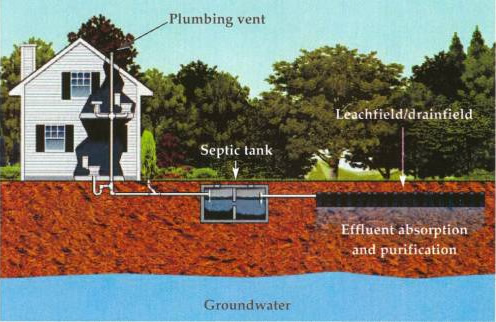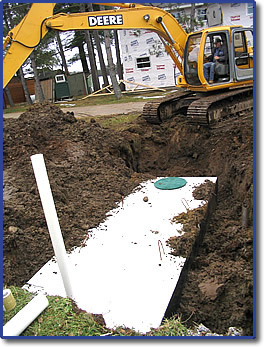|
Septic Systems
Basics of Septic Systems A septic system is an onsite wastewater treatment system that processes and purifies household waste (effluent). The effluent consists of black water (toilet wastes) and grey water (kitchen sink, bathtub, and laundry wastes). There are two main components to the septic system, the septic tank and the drain field. Primary treatment occurs in the tank where bacteria digest organic matter in the waste water. Secondary treatment occurs in the drain field where bacteria complete the digestion and purification of the effluent as it slowly infiltrates the soil. The septic tank is a watertight underground treatment tank constructed of concrete, plastic, or steel. It is approximately eight feet long, four feet wide, and five feet deep. The tank is used to retain, store, and treat solids, as well as release effluent to the drain field. The tank size is determined by the number of bedrooms in the dwelling. As waste water flows into the tank, the heavy solids settle to the bottom and become a sludge layer; while fats, oils, and greases float to the top forming a layer of scum. A zone of clear liquid between the layers of scum and sludge is called a clarified zone. All three layers have billions of bacteria that live naturally in the tank and perform the first phase of treatment to break down the solids in the tank. During the process of breaking down solids, gases are produced. These gases are vented from the septic tank through the plumbing vent on the rooftop. Tank filters keep any particles 1/8 inch or larger from leaving the tank. This increases the life of the drain field. All systems permitted after July 2000 are required to have a filter. Partially treated effluent flows from the septic tank to the drain field. The effluent is naturally purified as it percolates down through the soil.  In order for the effluent to properly purify, the distance between the drain field bottom and the water table should be equal to or greater than the minimum distance allowed by your local health department. The state of Wisconsin requires a minimum of three feet from the bottom of the drain field to a limiting factor. In order for the effluent to properly purify, the distance between the drain field bottom and the water table should be equal to or greater than the minimum distance allowed by your local health department. The state of Wisconsin requires a minimum of three feet from the bottom of the drain field to a limiting factor.The soil acts as a biological filter. It removes harmful substances from the effluent prior to it reaching the ground water. The type of system is determined by the soil test results. These are the types of systems typically used in our area:
Septic & Well Inspections with safe water analysis are generally preformed for real estate transactions. These are done by a licensed plumber and are used to evaluate the condition of the septic and well. This will also note any code violations. This is not to be confused with an inspection to satisfy the State and County requirements of plumbing. That only measures the amount of solids in the tank indicating it does not need to be pumped at that time. |